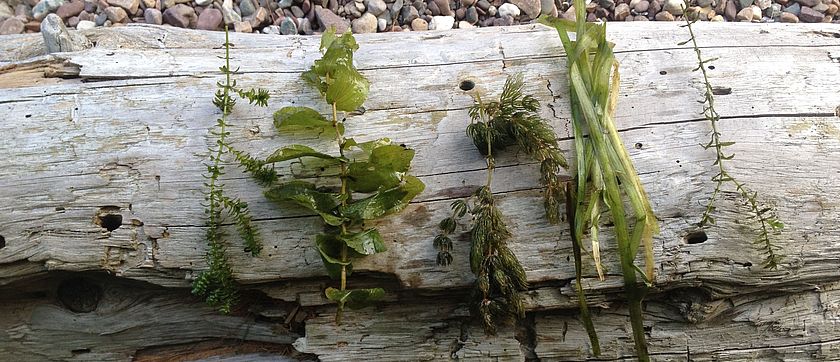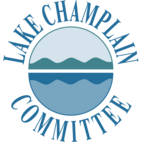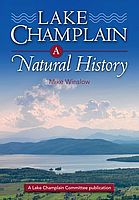
Lake Look
Lake Look is a monthly essay produced by the Lake Champlain Committee. Essays cover the natural history of the lake and current issues about lake management. Lake Look is distributed to newspapers throughout the basin and is available to members by email. Click here to sign up online to receive them. Links below take you to some recent columns. Click on "Archives" to access columns from previous years.
Many of the Lake Look columns have been pulled together in LCC's award-winning book LAKE CHAMPLAIN: A NATURAL HISTORY. This book is filled with intriguing facts and personal insights on various natural phenomena connected to Lake Champlain. This is a must-read if you enjoy the Lake Look essays and want entertaining stories and comprehensive understanding of the local environment in the Champlain Basin.
Recent Lake Look Articles
- Life in Little Glass Houses
April 2025 - Imagine a world where homes are built of glass—not by human hands, but by nature’s tiniest architects. These microscopic wonders, known as diatoms, are a type of single-celled algae that inhabit nearly every aquatic environment on Earth. Their unique biology makes them invaluable contributors to aquatic ecosystems and, surprisingly, to our daily lives.
- Ice Life: A Look Under a Frozen Lake Champlain
March 2025 - When temperatures drop low enough to freeze wide stretches of Lake Champlain, the landscape takes on a new character. Ice replaces rolling waves, creating a surface that invites exploration—whether by skaters gliding across its glassy expanse or anglers setting up for the season. Beneath the frozen surface, life continues, with some species thriving in the cold while others slow down.
- The Hidden Cost of Winter–How Road Salt is Undermining Infrastructure
February 2025 - It’s a familiar winter symphony in the Lake Champlain basin: snow, ice, and coarse rock salt crunch beneath your boots as you walk down the pavement. However, below the caked layers of snow, a quieter crisis is unfolding. Spreading road salt in pursuit of safer roads and sidewalks produces a cascade of unintended consequences that persist long after winter is over, corroding bridges, damaging roads, and compromising water systems.
- When Shell Freezes Over
January 2025 - In stressful times, one may envy a turtle: built-in safety from predators with their shells and free from modern expectations of speed and efficiency. Spending summers lounging on logs and rocks warmed by the sun and winters in seemingly peaceful hibernation. However, the winter months present survival obstacles for all animals in Lake Champlain, and turtles don’t have it easy. While hibernation may seem appealing to those who don’t enjoy the long cold nights of the season, it poses challenges with some surprising solutions.
- Gold Digging: LCC CHAMP Volunteer Finds the First Invasive Golden Clam in Lake Champlain
December 2024 - On a sunny late-October day, a dual-sided rake head tied to a twenty-five-foot length of rope sailed through the air and broke the previously still water of a boat launch in Whitehall, New York with a splash. Ashley Leemans, a volunteer with LCC's Champlain Aquatic invasive Monitoring Program, reeled in the rope, and picked through the pounds of submersed plants that collected on the tines to identify what species are present. While sifting through her first rake toss of the day, Ashley found something alarming.
- The Clean Water Act at 52
November 2024 - Unfortunately, the protection of something as fundamental as water has become a political issue. There is one major piece of federal legislation—The Clean Water Act (CWA)—which just celebrated its 52nd birthday on October 18, 2024. The Act shaped water policy in the United States and helped restore the quality of our country’s waters, but much has changed since its passage and recent court rulings have weakened its reach.
- What's the State of the Lake?
September 2024 - Every three years, the Lake Champlain Basin Program -- the entity that coordinates and helps fund implementation of the Lake Champlain restoration and management plan in partnership with New York, Vermont, and Quebec government agencies -- publishes a State of the Lake (SOTL) report. The 2024 edition released in June provides a health check up on the four goals of clean water, healthy ecosystems, informed and involved public, and thriving communities.
- A Watershed for Every Classroom
August 2024 - The Lake Champlain basin is full of stories that educators can use to teach all subjects, engage students in learning about their community, and integrate content, service, and a sense of belonging to their home watershed. To delve into these stories with teachers, the Lake Champlain Committee and our partners in the Champlain Basin Education Initiative (CBEI) hosted a course called Watershed for Every Classroom (WEC). The place-based educational program in the Lake Champlain watershed is part professional development and part summer camp for teachers.
- A Brief Natural History of Aquatic Plants
July 2024 - With summer in full swing, the native aquatic plants in Lake Champlain are spreading and blooming, adding pops of color to the water. How did they get here, and what helps make them successful away from land?
- Show Your Love for Lake Champlain This Summer!
June 2024 - Lake Champlain is abuzz this time of year. Aquatic plants leaf out and spread, insects dance along the water’s surface, and people flock to the beaches. All this activity brings to light not only the many things we love about the lake, but also the challenges we face in maintaining its water quality and ecological integrity: it’s the season of cyanobacteria blooms and invasive species spread. With that, it’s the “on-season” for LCC's on-the-water stewardship programs.
- The Living Fossil of Lake Champlain
May 2024 - The lake sturgeon is a fish with a lot of superlatives. It’s as long as the standing height of an adult man, with longer recorded lifespans than humans. It has been on earth since before the evolution of flowering plants. And it has a complicated relationship with people as it was nearly driven to extinction and is currently designated as endangered in Vermont and threatened in New York.
- Why Did the Salamander Cross the Road?
April 2024 - With no concept of weeks, months, or daylight savings—frogs and salamanders rely entirely on environmental cues of temperature and precipitation to tell them when it’s time to start their vernal lifestyle. What does this seasonal shift look like, and how have humans affected it?
- Say “No” to Neonicotinoids
March 2024 - Neonicotinoids, or "neonics" are versatile chemical pesticides that can be treated on a plant’s seeds so they’re built into the plant as it grows. As research continues to emerge on the harms that this class of chemicals has to the ecosystem beyond their targets, we need to seriously reconsider this practice and stop using these pesticides.
- How the Floods of 2023 Affected Fish
February 2024 - What effect did the floods of Summer and again in December in 2023 have on fish? We talked with Will Eldridge from Vermont Fish and Wildlife to see what these floods did for fish from the headwaters to the lake.
- Weird Duck Time
January 2024 - The four seasons of bird watching in the Northeast US: Elegant Songbird Spring, Subtle Treasures of Summer, Magnificent Fall Migrations, and the season we are now in—Weird Duck Time.
- Native Aquatic Plants in Winter
December 2023 - How do aquatic plants survive the winter in Lake Champlain?
- Duckweed: Little Plant, Big Misconceptions
November 2023 - From afar, a patch of bright green on any body of water is cause for alarm: we are too used to the sight of cyanobacteria plaguing shallow waters close to shore. But get closer to determine what you’re seeing. It may be neither cyanobacteria nor algae, but tiny, individual plants known as duckweed.
- Where’s the Beach?
October 2023 - If you have been to a beach on Lake Champlain any time since the Summer 2023 floods, you’ve probably noticed less of what you went there for: the beach. Water levels are still unseasonably high and shoreline areas that are usually dry are inundated from the floods and the consistent subsequent rain we’ve received. The average lake level for September in a typical year is just below 95 ft, and in 2023 it was over 97 ft. A difference of just over two feet may not sound too consequential, but it can have a range of significant shoreline impacts.
- Aquatic Invaders in Lake Champlain
September 2023 - When you look out at Lake Champlain from shore, you might see a swath of blue water shimmering below the mountains. Beneath that serene expanse is a buzz of ecological activity. Aquatic organisms in the lake are adapted specifically to each other, with zooplankton eating algae and bacteria, while fish, insects, and even some plants feed on zooplankton. A systems-level dance of life and death is performed under the surface of the lake, and it exists in a balance. Aquatic invasive species disrupt that balance.
- Flooding and Climate Resilience in the Lake Champlain Basin
August 2023 - The floods of July 2023 brought devastation to so many throughout the Lake Champlain Basin—they inundated homes and businesses, destroyed crops and livelihoods, and washed away roads. Rivers throughout the basin rushed to levels not seen in nearly 100 years, with staggeringly high flow ultimately pouring into Lake Champlain. What did the rivers carry, what does this mean for the lake, and how can we be more resilient in the future?
- Are you Stream Wise?
July 2023 - Vegetated stream buffers help improve water quality, mitigate floods, and provide habitat. LCC is a part of a new program that incentivizes landowners to maintain healthy buffers--read on to learn more about why and how to get involved.
- In Full (Cyanobacteria) Bloom
June 2023 - Cyanobacteria blooms can inundate shallow shorelines, which also happens to be where most people interact with the lake the most. Read on to learn about how to recognize cyanobacteria and what you can do to help.
- How Lake Trout Made Their Comeback in Lake Champlain
May 2023 - Annual stocking of lake trout in Lake Champlain has been halved for the 2023 season. It's a response to recent increases in wild recruitment, or survival past the first winter of life, of lake trout. While thousands of animal populations across taxa around the world plummet, the native lake trout here are making a comeback. Why?
- Go Home Foam
April 2023 - Bits of polystyrene foam are one of the most common pieces of inorganic debris collected in Lake Champlain beach sediment, and docks are a major source.
- The Faults in the Salt
March 2023 - When road salt dissolves, it needs to go somewhere—and in the Lake Champlain Basin, it winds up making our lake a bit saltier, which is bad news for freshwater life.
- Champlain Rain Disdain
February 2023 - Changes in precipitation patterns from climate change is fueling cyanobacteria blooms on multiple fronts. Learn about how soil management can help.
- All About Ice
January 2023 - Icy activities have been a part of life in the Lake Champlain basin for generations untold, but freezing frequency is expected to plummet due to climate change.
- Fish in Winter
December 2022 - Have you ever wondered what the fish of Lake Champlain are up to in the winter season?
- Imagine a Day without Water
November 2022 - The “Imagine a Day without Water” campaign is a useful tool for those fortunate enough to have easy access to fresh water. There are, however, areas even in the US, even in 2022, where this is not the case.
- Native Aquatic Plants
April 2021 - “Our underwater flora is often overlooked, but these plants are like trees in a forest: a vital part of the system, providing the stage on which life plays out below the surface of our lakes.”
- Chaousarou
November 2018 - “Evolutionarily speaking, longnose gar are considered living dinosaurs. Their long, needle-like snout is filled with rows of teeth, making them unmistakable from any other fish species.”
- A Long Winter’s Nap – How Turtles Weather Winter
January 2018 - Ah, to be a turtle… At first blush, they appear to have very comfortable lives. However, as idyllic and restful as a turtle’s winter might sound, hibernation is no easy task.
- Under Ice
November 2016 - Winter brings to Lake Champlain, and to the many smaller lakes and ponds around the Lake Champlain Basin, a window into a world where the normal rules of life are suspended. People who can't swim can walk on the water instead.
- The Limits of EPA's Pollution Plan for Lake Champlain
July 2016 - The long awaited revised TMDL for Lake Champlain has been released, but what will it actually achieve?
- Wipes Clog Pipes
June 2016 - Products mislabeled as "flushable" can cause serious sewer issues.
- Act Locally for Water Quality
May 2016 - Water quality protection starts in your own town.
- Reinvest in America
April 2016 - The failure to provide clean drinking water in Flint, MI is a reminder that maintaining infrastructure requires on-going investment.
- How Did We Get Here?
March 2016 - All lake's age. Some faster than others.
- Champlain Canal - Trapped in a Bureaucratic Web
February 2016 - a labyrinth of bureaucracy has prevented invasive species protections.
- Marimo in Lake Champlain
January 2016 - What are these little green balls?
- Horned Grebes
December 2015 - An introduction to a common winter waterfowl on Lake Champlain
- Improving Soil Health: Cover Crops and No-till Agriculture
November 2015 - Cover crops and no-till systems are two tools to improve soil health and perhaps reduce agricultural impacts on water quality.
- Looking Beyond Phosphorus
October 2015 - Phosphorus isn't the only thing driving an increase in algae blooms.
- EPA Releases New Champlain Pollution Budget
September 2015 - A look at EPA's new TMDL for Lake Champlain
- Electric Transmission and the Lake
August 2015 - Underwater transmission lines pose less environmental risk than overland lines.
- A Day at the Beach
July 2015 - How beaches and dunes form and the plants that grow there.
- What To Do With Waste?
June 2015 - How should human waste be disposed of after it has been treated?
- Using Wetlands for Flood Protection
May 2015 - Examples of wetlands limiting down steam flood damage.
- April Stool's Day
April 2015 - Pick up after your pets!
- Manure Happens
March 2015 - Proper manure management by farms is important for protecting water quality
- Salty Water
February 2015 - How important is road salt as a water quality issue in Lake Champlain?
- Microcystin - How Much Is Too Much?
October 2014 - Lack of nationwide drinking water standards for algae toxins has led to confusion.
- Spiny Water Flea Have Arrived - What Next?
September 2014 - Predictions about the ecological impacts of Lake Champlain's latest invasive species - the spiny water flea.
- The Lake Protection Pledge
August 2014 - Steps all basin residents can take to reduce their impact on Lake Champlain
- Monitoring Cyanobacteria Blooms
July 2014 - How do we know when and where cyanobacteria blooms occur on the lake?
- Bass Tournaments
May 2014 - Does the proliferation of fishing tournaments affect the health of the lake?
- Rail Transport of Oil Poses Lake Risk
April 2014 - The boom in fossil fuel extraction out west means a huge increase in traffic of dangerous unit trains along the shore of Lake Champlain
- Planning Shoreline Protection Projects
March 2014 - What factors should landowners consider before undertaking erosion control projects?
- Nurdles to Neuston
February 2014 - small plastic pellets from soaps and other products can be found in our waters
- Pharmaceuticals in Water
January 2014 - drugs from our medicine cabinets are getting into our water. What does it mean?
- Agricultural Tile Drains - Beneficial or Costly?
December 2013 - what does the spread of tile drainage mean for Lake Champlain water quality?
- Tenuous Links Between Cyanobacteria and Neurological Diseases
November 2013 - evidence is unclear about whether cyanobacteria might play a role in Parkinson's or Alzheimer's disease
- Chaousarou
October 2013 - Learn more about a real Lake Champlain "monster", the long-nosed gar
- Archives
Access to older Lake Look columns

